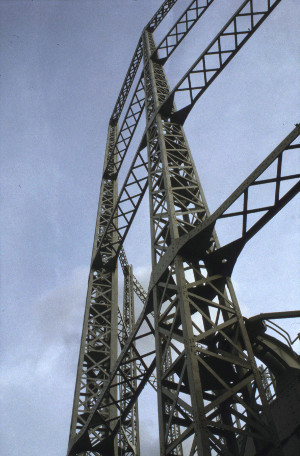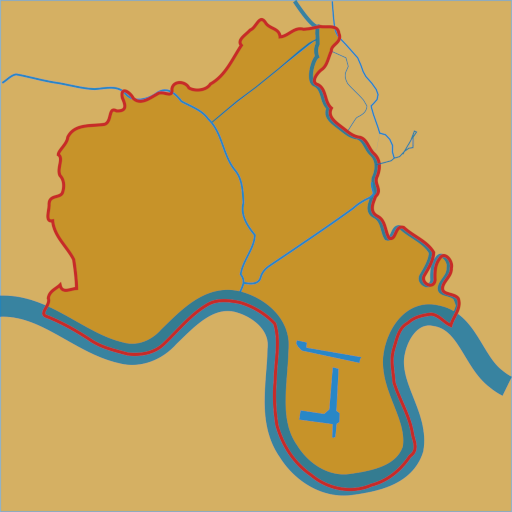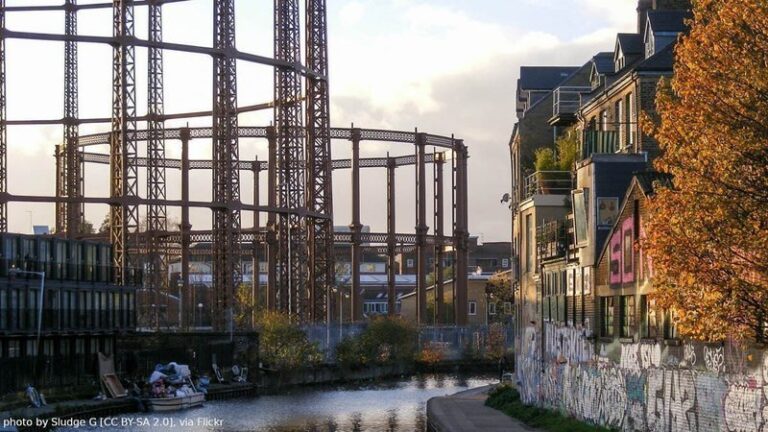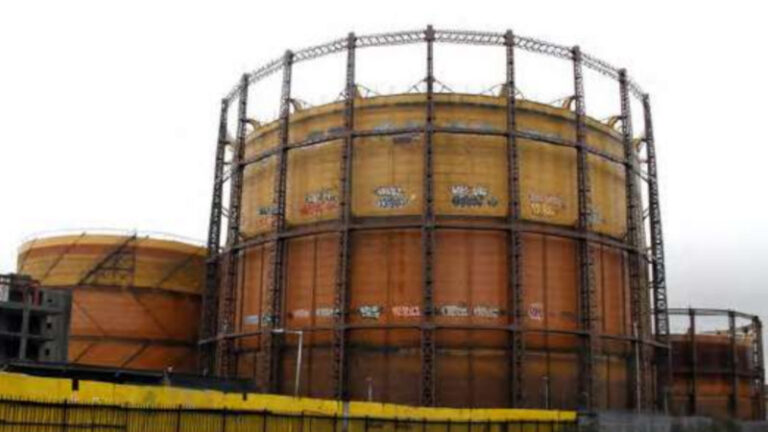THE HISTORIC NO. 2 AND NO.5 GASHOLDERS AT THE BETHNAL GREEN HOLDER STATION
MARIAN PLACE, LONDON BOROUGH OF TOWER HAMLETS

The Bethnal Green Holder Station was established in the 1850s as a detached holder station for the Shoreditch Gasworks of the Imperial Gas Light and Coke Company, which opened in 1823. The site of the Shoreditch Gasworks is now occupied by Haggerston Park in LB Hackney. The old brick walls in the park are the retained walls of the gasworks. Also retained in the northwest corner is the dry southern end of Haggerston Basin: a short narrow basin off the Regent’s Canal used by barges delivering coal to the gasworks. Unlike the gasworks, the holder station was built on the Regent’s Canal; and both historic gasholders are situated near to the south side of the canal.
The No. 2 gasholder was designed by the engineer in charge of the Shoreditch Gasworks, Joseph Clark; and completed by Westwood and Wright’s of Dudley in December 1866. It has a columnar guide frame of 16 cast-iron columns on a circular in-ground brick tank, 134 feet in diameter. Each column consists of two superimposed classical columns: a lower Doric column and an upper Corinthian column, separated by a rectangular junction box for the lower ring of decorative cast- and wrought-iron girders. The upper ring being bolted to rectangular junction boxes on top of the Corinthian columns.
The lower junction boxes have lost their applied mouldings; the capitals of the Corinthian columns have lost their leafwork; and the upper junction boxes have lost their superimposed cornice blocks. Despite these losses, the No. 2 gasholder’s guide frame was clearly designed to a very high standard of orthodox classical detailing.
The No. 2 is also the smallest and earliest surviving of a series of gasholders designed by Joseph Clark for the Imperial Gas Light and Coke Company. A number of these survive in the large group of Grade-II-listed gasholders at the Bromley-by-Bow Holder Station on the east bank of the River Lea, in LB Newham.

In 1876, the Imperial Gas Light and Coke Company merged with the Chartered Gas Light and Coke Company to form the Gas Light and Coke Company, which was the world’s largest gas undertaking until nationalisation in 1949.
The No. 5 gasholder was designed by the new company’s engineer, George Trewby, and was completed in 1889. It has a lattice guide frame of 22 steel box-lattice guide standards on a circular in-ground concrete tank 200 feet in diameter and 50 feet in depth. The elegant tapering guide standards are joined by four rings or wrought-iron or steel girders with lattice webs. The No.5 gasholder’s lattice guide frame of 1888-89 is a mature example of its type: compared to the first examples erected in the 1870s, of which the No. 1 gasholder at the Poplar Holder Station in LB Tower Hamlets is the earliest now surviving.
At 146 feet, the No.5 is twice the height of the No.2 and makes the dominant contribution to the canalscape. However, the setting of each gasholder is enhanced by the proximity of the other. Furthermore, they are the only surviving adjacent gasholders in London which represent the two main types of 19th century gasholder guide frame in London, which was the birthplace of the gas industry; and until recently, the No.2 gasholder was the oldest in operational use in the country.
There were four gasworks along the 8¾-mile-long Regent’s Canal, which was opened in 1820. The canal’s main trade was coal, carried in barges from Regent’s Canal Dock (now Limehouse Basin) to supply the Stepney, Shoreditch, Haggerston and St Pancras Gasworks, and numerous coal merchants. Of the few surviving historic gasholders on or near the Regent’s Canal, the four gasholders at St Pancras are being relocated on new sites, whereas the two at Bethnal Green are in their original positions. They are also nearest to Limehouse Basin. At the basin, there are two surviving structures associated with transhipping coal from the North Sea collier to the Regent’s Canal barge.
Furthermore, along the canal between Limehouse Basin and the Bethnal Green gasholders there are structures and buildings associated with the coal trade. At the site of the Stepney Gasworks, there are remnants of a coal-handling structure and a coal store; and four reinstated lower parts of gasholder guide frame columns dating from the mid-1850s, which are now probably the oldest surviving parts of gasholder guide frame columns in the world. Surviving next to the canal at Mile End Road is an 1820 house built by John Gardner, who operated a fleet of canal barges carrying coal, timber, bricks and malt. Also, at Twig Folly Wharf, London’s only surviving canal barge builder’s building.
Tom Ridge
September 2014
East End Waterway Group

Local residents, schools, community groups, amenity societies and businesses working with British Waterways, Tower Hamlets Council and others for the protection and beneficial use of the six-mile waterway ‘ring’, its historic buildings, structures and habitats.
[emailpetition id=”6″]


Hi,
I’ve just interviewed Tom Ridge for an article about this petition, he told me to contact Mark Taylor for further information about how the online petition is doing but am unable to find an email address on here?
Please email [email protected] with any further contact details if possible!
Ellie Flynn
[…] Find out more and sign the petition at residents-first.xyz. […]
I am an artist and I have made a print of theses holders . It is very popular and shows peoples appreciation of these Holders. Most of my customers are local to them and tell me how much they love them. In a wider thought It just seems awful to keep removing everything in London that reminds us of our past. Structures like these are beautifully engineered and there is nothing like them now to inspire engineers of the future.Please think again Clare
I’d love some prints, Clare. Can you get in touch? Cheers, Lleyam
I would love some prints too! How can I get in touch? Thanks, Rebecca
[…] lovely folk at Residents First have started a petition for Tower Hamlets council to save the gasholders – we’ve signed and if you feel this is a […]
These are a unique part of our cultural and industrial heritage. They deserve to be listed monuments, celebrated and restored to be enjoyed by the public. They create a sense of place and community.
The only reason the gasholders would be demolished is to sell the land to wealthy ( foreign) investors….. The holders are iconic and should be listed
To much of the East End is be pulled down and soulless buildings erected, some of these old buildings need to be preserved to show our past industrial history and culture
[…] View the East End Waterway group petition here: www.residents-first.xyz/no-2-and-no-5-gasholders-at-the-bethnal/ […]
Has anyone seen what they’ve done to the gas works in kings cross?? They look fine, even good, and they’re flats so everyone should be happy. There is now 0 excuses to knock them down thank god!
It is a shame that technology has finally moved enough for these ancient structures (by industrial standards) to have survived long enough to get to the stage, where their destruction has evoked a forum where people are discussing if they should be conserved or re-purposed or not.
Gasholders are exceptionally simplistic structures. Their architectural and asthectic prowes being was down entirely to the designers making a statement. Usually of power and presence. Some of acceptance to the local area. I suggest the two column guided holders at Bethnal Green prove this.
I like gasholders and would like to see the many large examples in the Greater London area re-purposed. If they cannot be reused in their current location they should be dismantled and stored so that they could be used elsewhere in the country where their unique shapes would be useful.
The actual Bell or the container that holds the gas is redundant and useless. The Rollers and other equipment attached to the Bell could be reused. However in reality the spiral guided holders, of which there are many, and the MAN and Wiggins types have seen their day. They don’t have any appeal really. Even though they may have made technological advances that may have been used in other buildings around the world.
I was shocked to pass the site of No7 holder at Fulham recently to see it being hot cut and demolished. It was a particularly good looking example. It should have been dismantled and stored. It is essentially bolted together. I may be speaking out of turn, but it’s the cost of remediation of the site rather than demolition of structures that is expensive. It is only the frame that should be conserved.
The other holder No2 I think is to be retained. It is the oldest surviving holder and it will be left as a functionless climbing frame that will get vandalised and cut up for safety reasons. No7 could have been easily reused and re-purposed. No2 would have been better being dismantled and moved to a Gas or industrial museum and reactivate as a gasholder.
London has a lot of excellent gasholders of various sizes. Many that could be re-purposed. Many of them were built on virgin soil. The holders at the larger works were built at the same time as the production plant. I’ll quote Beckton No8, North Greenwich and the holders at West Ham. I will stand corrected of course.
I was unsure what the gasholders at King’s Cross would turn out like, but I confess they have done a very good job.
I support your quest to get these two holders reused and re-purposed.